Simultaneous Coded Plane-Wave Imaging Using an Advanced Ultrasound Forward Model
Abstract
1. Introduction
2. Materials and Methods
2.1. Model Using Two Transducers
2.2. Discretization of the Model
2.3. Derivation of the Model for Plane-Wave Imaging
2.4. Temporal Encoding for Simultaneous Emission of Plane Waves
- (a)
- Emit a PW in the direction and receive its backscattered echoes ;
- (b)
- Build the corresponding concatenated kernel using Equation (12);
- (c)
- Repeat steps (a) and (b) times with a different angle ;
- (d)
- Build the total observation vector of size using:where each is computed using Equation (12);
- (e)
- Build the enhanced kernel of size using:where each is computed using Equation (12).
2.5. Discretization of the Coded Excitation PW Forward Model
2.6. Inverse Problem Statement
2.7. Experiment Parameters
2.8. Reconstruction Using Delay and Sum
2.9. Image Quality Metrics
- Spatial resolution—quantifies the main lobe width of a point scatterer. The spatial resolution is quantified by the full width at half maximum (FWHM), which measures the spatial spreading of a point scatterer in the −6 dB interval. The spatial resolution FWHM is measured both axially and laterally.
- Peak-to-center intensity difference (PCID)—quantifies the ability to separate two scatterers in the reconstructed image [48,49]. PCID is a measurement of the minimum value of intensity in the pixels that separate two maxima corresponding to the scatterers. We consider that two scatterers are separate if PCID is at least -6 dB. PCID is computed both axially and laterally for the TRF estimations , , and .
2.10. Temporal Plane-Wave Encoding
- (a)
- is designed as a chirp waveform emitted with an angle :where B = 5.1 MHz is the bandwidth of the ultrasound probe, T = 18.55 s is the waveform duration, is the central frequency of the probe, and is a 20% Tukey window of duration T. The instantaneous frequency of the signal grows with time and thus is called an ‘up’ chirp.
- (b)
- In the same way as , is designed as a ‘down’ chirp waveform emitted with an angle :
- (c)
- is designed as a ’up–down’ chirp, with slopes twice as steep as and , emitted with an angle :
- (d)
- The excitation signals are deduced from the relation , using the following Wiener filter:where the parameter can be empirically tuned to bypass zero division (outside the bandwidth of ) [51], and and are the Fourier transforms of and , respectively.
2.11. On the Gain in Acquisition Time
3. Results
3.1. Wire Phantom Simulation
3.2. Wire Phantom Experiment
4. Conclusions
Author Contributions
Funding
Institutional Review Board Statement
Informed Consent Statement
Data Availability Statement
Acknowledgments
Conflicts of Interest
Appendix A. Formulation of the Cji Matrix for Planar Transducers
Appendix B. Establishment of the General Forward Model
Appendix C. Estimation of the Condition Number of Kernel Ψ
References
- Tanter, M.; Fink, M. Ultrafast imaging in biomedical ultrasound. IEEE Trans. Ultrason. Ferroelectr. Freq. Control 2014, 61, 102–119. [Google Scholar] [CrossRef] [PubMed]
- Shattuck, D.P.; Weinshenker, M.D.; Smith, S.W.; von Ramm, O.T. Explososcan: A parallel processing technique for high speed ultrasound imaging with linear phased arrays. J. Acoust. Soc. Am. 1984, 75, 1273–1282. [Google Scholar] [CrossRef] [PubMed]
- Smith, S.W.; Pavy, H.G., Jr.; von Ramm, O.T. High-speed ultrasound volumetric imaging system. I. Transducer design and beam steering. IEEE Trans. Ultrason. Ferroelectr. Freq. Control 1991, 38, 100–108. [Google Scholar] [CrossRef]
- von Ramm, O.T.; Smith, S.W.; Pavy, H.G., Jr. High-speed ultrasound volumetric imaging system. II. Parallel processing and image display. IEEE Trans. Ultrason. Ferroelectr. Freq. Control 1991, 38, 109–115. [Google Scholar] [CrossRef] [PubMed]
- Badescu, E.; Garcia, D.; Joos, P.; Bernard, A.; Augeul, L.; Ferrera, R.; Viallon, M.; Petrusca, L.; Friboulet, D.; Liebgott, H. Comparison Between Multiline Transmission and Diverging Wave Imaging: Assessment of Image Quality and Motion Estimation Accuracy. IEEE Trans. Ultrason. Ferroelectr. Freq. Control 2019, 66, 1560–1572. [Google Scholar] [CrossRef]
- Johnson, S.A.; Greenleaf, J.F.; Duck, F.A.; Chu, A.; Samayou, W.R.; Gilbert, B.K. Digital computer simulation study of a real-time collections, post processing synthetic focusing ultrasound cardiac camera. Acoust. Hologr. 1975, 6, 193–211. [Google Scholar]
- Delannoy, B.; Torgue, R.; Bruneel, C.; Bridou, E. Ultrafast electronical image reconstruction device. In Echocardiology; Springer: Dordrecht, Germany, 1979; Volume 1. [Google Scholar]
- Delannoy, B.; Torgue, R.; Bruneel, C.; Bridoux, E.; Rouvaen, J.M. Acoustical image reconstruction in parallel-processing analog electronic systems. J. Appl. Phys. 1979, 50, 3153–3159. [Google Scholar] [CrossRef]
- Lockwood, G.R.; Talman, J.R.; Brunke, S.S. Real-time 3D ultrasound imaging using sparse synthetic aperture beamforming. IEEE Trans. Ultrason. Ferroelectr. Freq. Control 1998, 45, 980–988. [Google Scholar] [CrossRef]
- Hazard, C.R.; Lockwood, G.R. Theoretical assessment of a synthetic aperture beamformer for real-time 3-D imaging. IEEE Trans. Ultrason. Ferroelectr. Freq. Control 1999, 46, 972–980. [Google Scholar] [CrossRef]
- Nikolov, S.I.; Jensen, J.A. In-vivo synthetic aperture flow imaging in medical ultrasound. IEEE Trans. Ultrason. Ferroelectr. Freq. Control 2003, 50, 848–856. [Google Scholar] [CrossRef]
- Udesen, J.; Gran, F.; Hansen, K.L.; Jensen, J.A.; Thomsen, C.; Nielsen, M.B. High frame-rate blood vector velocity imaging using plane waves: Simulations and preliminary experiments. IEEE Trans. Ultrason. Ferroelectr. Freq. Control 2008, 55, 1729–1743. [Google Scholar] [CrossRef] [PubMed]
- Sandrin, L.; Catheline, S.; Tanter, M.; Hennequin, X.; Fink, M. Time-resolved pulsed elastography with ultrafast ultrasonic imaging. Ultrason. Imaging 1999, 21, 259–272. [Google Scholar] [CrossRef] [PubMed]
- Sandrin, L.; Tanter, M.; Catheline, S.; Fink, M. Shear modulus imaging with 2-D transient elastography. IEEE Trans. Ultrason. Ferroelectr. Freq. Control 2002, 49, 426–435. [Google Scholar] [CrossRef] [PubMed]
- Hasegawa, H.; Kanai, H. High-frame-rate echocardiography using diverging transmit beams and parallel receive beamforming. J. Med. Ultrason. 2011, 38, 129–140. [Google Scholar] [CrossRef] [PubMed]
- Nikolov, S.I. Synthetic Aperture Tissue and Flow Ultrasound Imaging. Ph.D. Thesis, Department of Biomedical Engineering, Ørsted-DTU, Technical University of Denmark, Lyngby, Denmark, 2001. [Google Scholar]
- Tanter, M.; Bercoff, J.; Sandrin, L.; Fink, M. Ultrafast compound imaging for 2-D motion vector estimation: Application to transient elastography. IEEE Trans. Ultrason. Ferroelectr. Freq. Control 2002, 49, 1363–1374. [Google Scholar] [CrossRef]
- Montaldo, G.; Tanter, M.; Bercoff, J.; Benech, N.; Fink, M. Coherent plane-wave compounding for very high frame rate ultraso nography and transient elastography. IEEE Trans. Ultrason. Ferroelectr. Freq. Control 2009, 56, 489–506. [Google Scholar] [CrossRef]
- Papadacci, C.; Pernot, M.; Couade, M.; Fink, M.; Tanter, M. High-contrast ultrafast imaging of the heart. IEEE Trans. Ultrason. Ferroelectr. Freq. Control 2014, 61, 288–301. [Google Scholar] [CrossRef]
- Liebgott, H.; Rodriguez-Molares, A.; Jensen, J.A.; Bernard, O. Plane-Wave Imaging Challenge in Medical Ultrasound. In Proceedings of the IEEE International Ultrasonics Symposium (IUS), Tours, France, 18–21 September 2016. [Google Scholar]
- Miwa, H.; Hayashi, H.; Shimura, T.; Murakami, K. Simultaneous multifrequency ultrasonography the principle and technology. In Proceedings of the IEEE International Ultrasonics Symposium (IUS), Chicago, IL, USA, 14–16 October 1981. [Google Scholar]
- O’Donnell, M. Coded excitation system for improving the penetration of real-time phased-array imaging systems. IEEE Trans. Ultrason. Ferroelectr. Freq. Control 1992, 39, 341–351. [Google Scholar] [CrossRef]
- Haider, B.; Lewin, P.A.; Thomenius, K.E. Pulse elongation and deconvolution filtering for medical ultrasonic imaging. IEEE Trans. Ultrason. Ferroelectr. Freq. Control 1998, 45, 98–113. [Google Scholar] [CrossRef]
- Misaridis, T.; Jensen, J.A. Use of modulated excitation signals in medical ultrasound. Part I: Concepts and expected benefits. IEEE Trans. Ultrason. Ferroelectr. Freq. Control 2005, 52, 177–191. [Google Scholar] [CrossRef]
- Shen, J.; Ebbini, E.S. A new coded-excitation ultrasound imaging system. I. Basic principles. IEEE Trans. Ultrason. Ferroelectr. Freq. Control 1996, 43, 131140. [Google Scholar] [CrossRef]
- Misaridis, T.; Jensen, J.A. Space-time encoding for high frame rate ultrasound imaging. Ultrasonics 2002, 40, 593–597. [Google Scholar] [CrossRef] [PubMed]
- Hernández, A.; Urena, J.; Garcia, J.J.; Mazo, M.; Hernanz, D.; Derutin, J.P.; Sérot, J. Ultrasonic ranging sensor using simultaneous emissions from different transducers. IEEE Trans. Ultrason. Ferroelectr. Freq. Control 2004, 51, 1660–1670. [Google Scholar] [CrossRef] [PubMed]
- Misaridis, T.; Fink, M.; Jensen, J.A. Complex pulsing schemes for high frame rate imaging. In Proceedings of the IEEE IUS, Munich, Germany, 8–11 October 2002. [Google Scholar]
- Gran, F.; Jensen, J.A. Spatio-temporal encoding using narrow-band linearly frequency modulated signals in synthetic aperture ultrasound imaging. In Proceedings of the Medical Imaging 2005: Ultrasonic Imaging and Signal Processing, San Diego, CA, USA, 12–17 February 2005; pp. 405–416. [Google Scholar]
- Gran, F.; Jensen, J.A. Spatial encoding using a code division technique for fast ultrasound imaging. IEEE Trans. Ultrason. Ferroelectr. Freq. Control 2008, 55, 12–23. [Google Scholar] [CrossRef]
- Bujoreanu, D.; Liebgott, H.; Nicolas, B. Simultaneous coded plane wave imaging in ultrasound: Problem formulation and constraints. In Proceedings of the IEEE ICASSP, New Orleans, LA, USA, 5–9 March 2017. [Google Scholar]
- Bujoreanu, D.; Bernard, A.; Nicolas, B.; Liebgott, H.; Friboulet, D. Simultaneous coded plane wave imaging: Implementation on a research echograph. In Proceedings of the IEEE IUS, Washington, DC, USA, 6–9 September 2017. [Google Scholar]
- David, G.; Robert, J.-L.; Zhang, B.; Laine, A.F. Time domain compressive beam forming of ultrasound signals. J. Acoust. Soc. Am. 2015, 137, 2773–2784. [Google Scholar] [CrossRef]
- Zhang, B.; Robert, J.-L.; David, G. Dual-domain compressed beamforming for medical ultrasound imaging. In Proceedings of the 2015 IEEE International Ultrasonics Symposium (IUS), Taipei, Taiwan, 21–24 October 2015. [Google Scholar]
- Besson, A.; Carrillo, R.E.; Bernard, O.; Wiaux, Y.; Thiran, J.P. Compressed delay-and-sum beamforming for ultrafast ultrasound imaging. In Proceedings of the 2016 IEEE International Conference on Image Processing (ICIP), Phoenix, AZ, USA, 25–28 September 2016. [Google Scholar]
- Besson, A.; Perdios, D.; Martinez, F.; Chen, Z.; Carrillo, R.E.; Arditi, M.; Thiran, J.P. Ultrafast ultrasound imaging as an inverse problem: Matrix-free sparse image reconstruction. IEEE Trans. Ultrason. Ferroelectr. Freq. Control 2017, 65, 339–355. [Google Scholar] [CrossRef]
- Besson, A.G.J.; Roquette, L.; Perdios, D.; Arditi, M.; Hurley, P.; Wiaux, Y.; Thiran, J.P. Fast Non-stationary Deconvolution in Ultrasound Imaging. IEEE Trans. Comput. Imaging 2018, 7, 935–947. [Google Scholar]
- Jensen, J.A.; Svendsen, N.B. Calculation of pressure fields from arbitrarily shaped, apodized, and excited ultrasound transducers. IEEE Trans. Ultrason. Ferroelectr. Freq. Control 1992, 39, 262–267. [Google Scholar] [CrossRef]
- PMorse, M.; Ingard, K.U. Theoretical Acoustics; Princeton University Press: Princeton, NJ, USA, 1968. [Google Scholar]
- Stepanishen, P.R. Pulsed transmit/receive response of ultrasonic piezoelectric transducers. J. Acoust. Soc. Am. 1981, 69, 1815–1827. [Google Scholar] [CrossRef]
- Jensen, J.R.A. A model for the propagation and scattering of ultrasound in tissue. J. Acoust. Soc. Am. 1991, 89, 182–190. [Google Scholar] [CrossRef]
- Tupholme, G.E. Generation of acoustic pulses by baffled plane pistons. Mathematika 1969, 16, 209–224. [Google Scholar] [CrossRef]
- Porée, J.; Posada, D.; Hodzic, A.; Tournoux, F.; Cloutier, G.; Garcia, D. High-Frame-Rate Echocardiography Using Coherent Compounding With Doppler-Based Motion-Compensation. IEEE Trans. Med. Imaging 2016, 35, 1647–1657. [Google Scholar] [CrossRef] [PubMed]
- Idier, J.; Demoment, G. Main Approaches to the Regularization of Ill-posed Problems. In Bayesian Approach to Inverse Problems; John Wiley and Sons: Hoboken, NJ, USA, 2008; pp. 41–58. [Google Scholar]
- Byram, B.; Dei, K.; Tierney, J.; Dumont, D. A model and regularization scheme for ultrasonic beamforming clutter reduction. IEEE Trans. Ultrason. Ferroelectr. Freq. Control 2015, 62, 1913–1927. [Google Scholar] [CrossRef] [PubMed]
- Beck, A.; Teboulle, M. A fast iterative shrinkage-thresholding algorithm for linear inverse problems. SIAM J. Imaging Sci. 2009, 2, 183–202. [Google Scholar] [CrossRef]
- Jensen, J.A. Field: A Program for Simulating Ultrasound Systems. Med. Biol. Eng. Comput. 1996, 34 (Suppl. S1), 351–353. [Google Scholar]
- Fan, C.; Caleap, M.; Pan, M.; Drinkwater, B.W. A comparison between ultrasonic array beamforming and super resolution imaging algorithms for non-destructive evaluation. Ultrasonics 2014, 54, 1842–1850. [Google Scholar] [CrossRef]
- Laroche, N.; Bourguignon, S.; Carcreff, E.; Idier, J.; Duclos, A. An inverse approach for ultrasonic imaging from full matrix capture data: Application to resolution enhancement in NDT. IEEE Trans. Ultrason. Ferroelectr. Freq. Control 2020, 67, 1877. [Google Scholar] [CrossRef]
- Jensen, J.; Stuart, M.B.; Jensen, J.A. Optimized Plane Wave Imaging for Fast and High-Quality Ultrasound Imaging. IEEE Trans. Ultrason. Ferroelectr. Freq. Control 2016, 63, 1922–1934. [Google Scholar] [CrossRef]
- Widrow, B.; Glover, J.R.; McCool, J.M.; Kaunitz, J.; Williams, C.S.; Hearn, R.H.; Zeidler, J.R.; Dong, E., Jr.; Goodlin, R.C. Adaptive noise cancelling: Principles and applications. Proc. IEEE 1975, 63, 1692–1716. [Google Scholar] [CrossRef]
- Nowicki, A.; Trots, I.; Lewin, P.A.; Tymkiewicz, R. Influence of the ultrasound transducer bandwidth on selection of the complementary Golay bit code length. Ultrasonics 2007, 47, 64–73. [Google Scholar] [CrossRef]
- Trots, I.; Nowicki, A.; Secomski, W.; Litniewski, J. Golay sequences-side-lobe-canceling codes for ultrasonography. Arch. Acoust. 2004, 29, 87–97. [Google Scholar]
- Oelze, M.L. Bandwidth and resolution enhancement through pulse compression. IEEE Trans. Ultrason. Ferroelectr. Freq. Control 2007, 54, 768–781. [Google Scholar] [CrossRef] [PubMed]
- Benane, Y.M.; Bujoreanu, D.; Lavarello, R.; Varray, F.; Escoffre, J.M.; Novell, A.; Cachard, C.; Basset, O. Experimental Implementation of a Pulse Compression Technique using Coherent Plane Wave Compounding. IEEE Trans. Ultrason. Ferroelectr. Freq. Control 2018, 65, 1025–1036. [Google Scholar] [CrossRef] [PubMed]
- Benane, Y.M.; Lavarello, R.; Bujoreanu, D.; Cachard, C.; Varray, F.; Basset, O. Ultrasound bandwidth enhancement through pulse compression using a CMUT probe. In Proceedings of the 2017 IEEE International Ultrasonics Symposium (IUS), Washington, DC, USA, 6–9 September 2017. [Google Scholar]
- Errico, C.; Pierre, J.; Pezet, S.; Desailly, Y.; Lenkei, Z.; Couture, O.; Tanter, M. Ultrafast ultrasound localization microscopy for deep super-resolution vascular imaging. Nature 2015, 527, 499–502. [Google Scholar] [CrossRef] [PubMed]
- Ongie, G.; Jalal, A.; Metzler, C.A.; Baraniuk, R.G.; Dimakis, A.G.; Willett, R. Deep Learning Techniques for Inverse Problems in Imaging. IEEE J. Sel. Areas Inf. Theory 2020, 1, 39–56. [Google Scholar] [CrossRef]
- Holfort, I.K.; Gran, F.; Jensen, J.A. Broadband minimum variance beamforming for ultrasound imaging. IEEE Trans. Ultrason. Ferroelectr. Freq. Control 2009, 56, 314–325. [Google Scholar] [CrossRef]
- Briguet, A.; Fanet, H.; Sappey-Marinier, D.; Vray, D. Imagerie Médicale à Base de Champs Magnétiques et D’ultrasons. 2014. Available online: https://hal.archives-ouvertes.fr/hal-00976650/ (accessed on 1 September 2022).
- Carcreff, E.; Bourguignon, S.; Idier, J.; Simon, L. A linear model approach for ultrasonic inverse problems with attenuation and dispersion. IEEE Trans. Ultrason. Ferroelectr. Freq. Control 2014, 61, 1191–1203. [Google Scholar] [CrossRef]

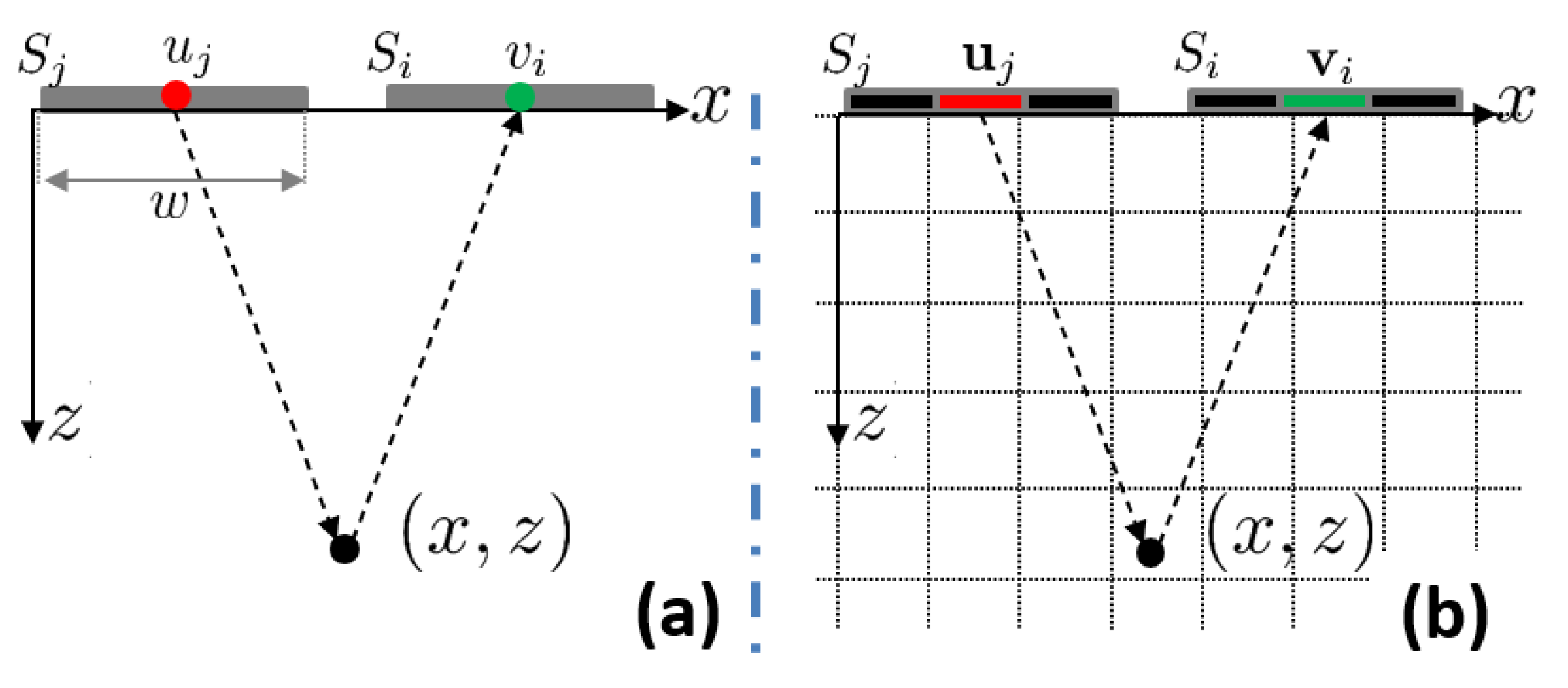
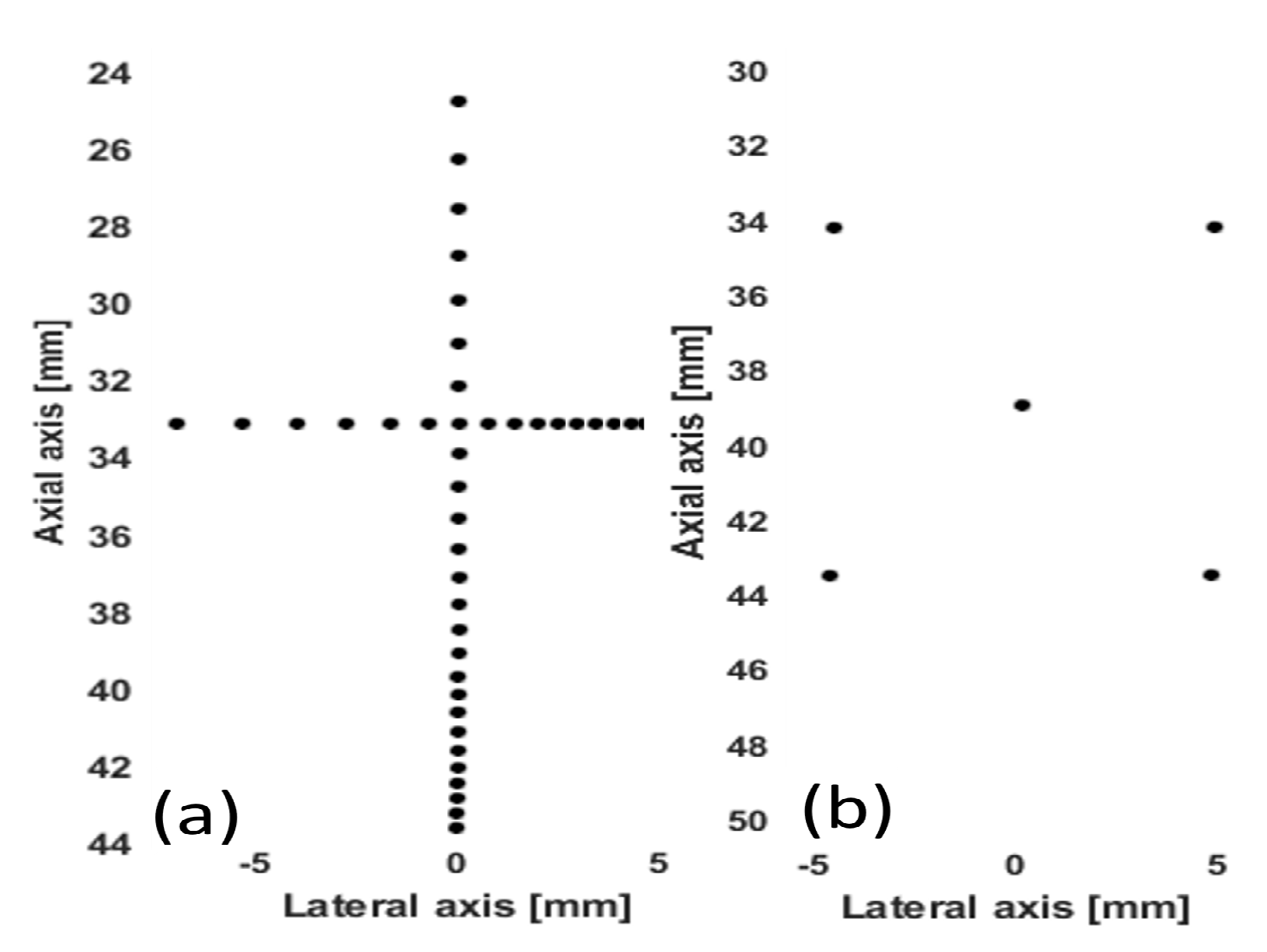
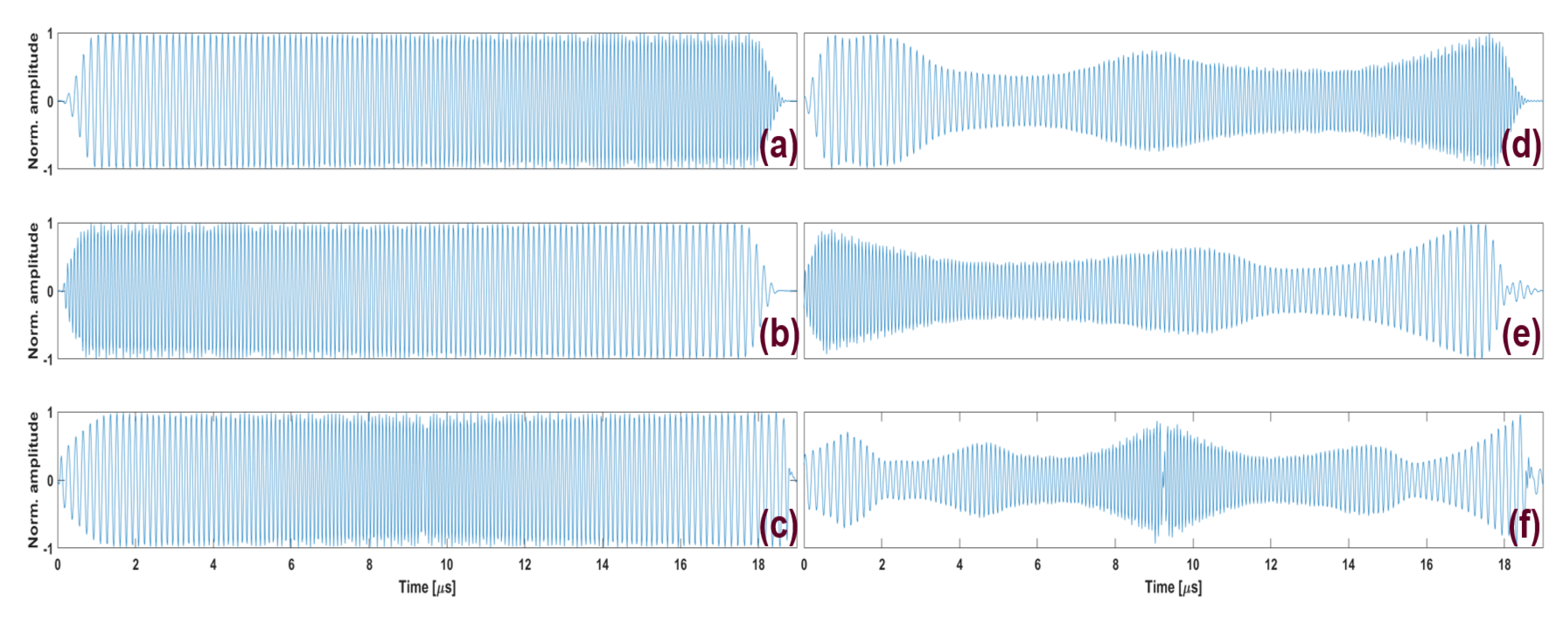
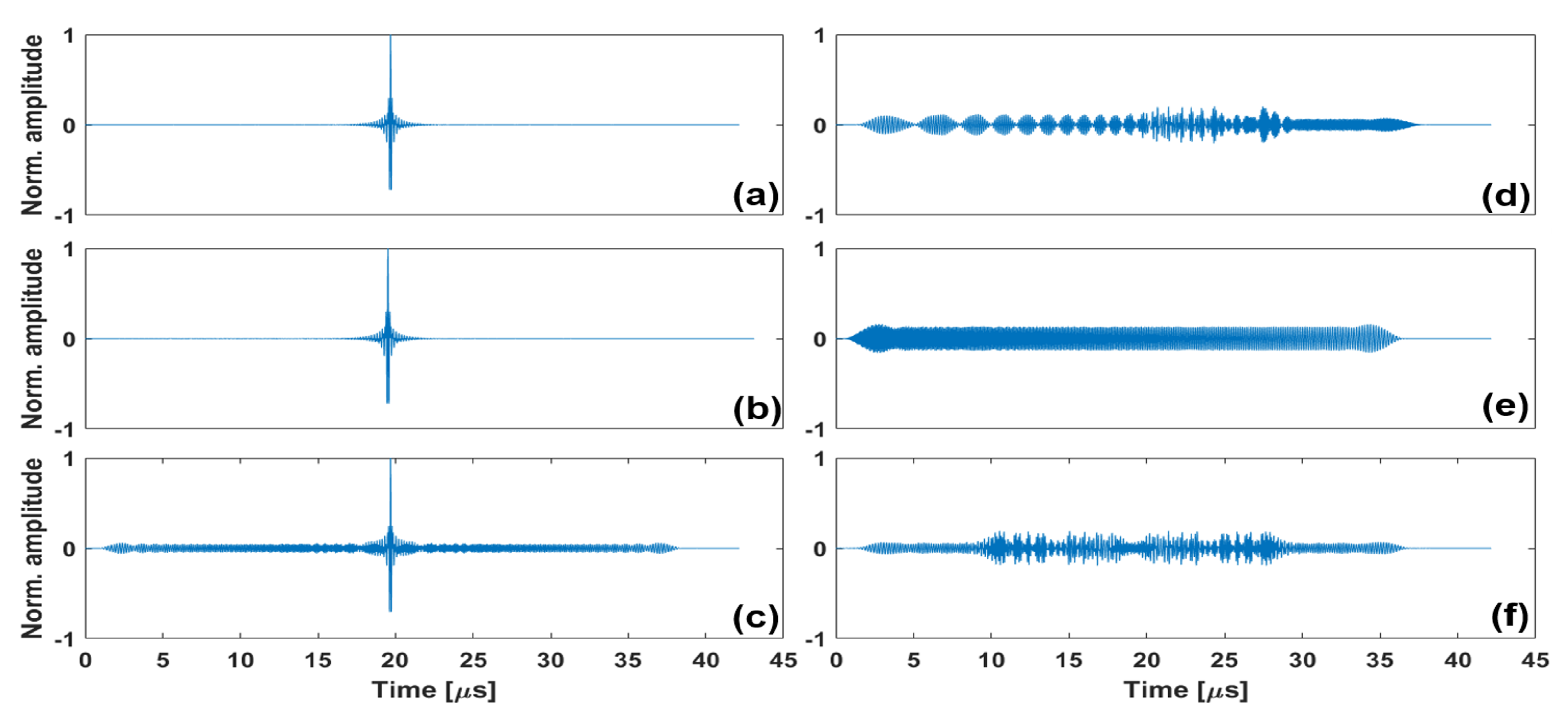
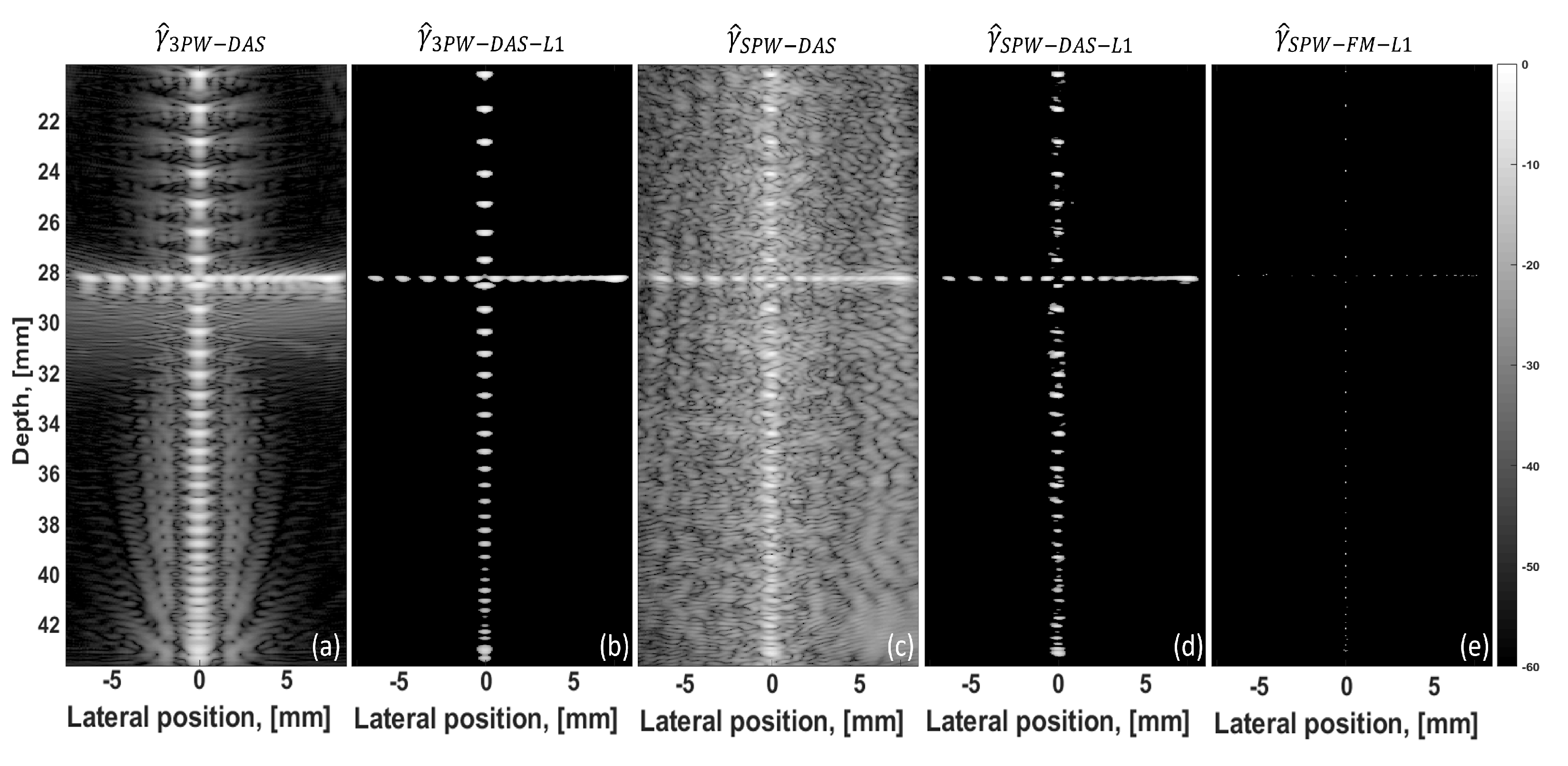
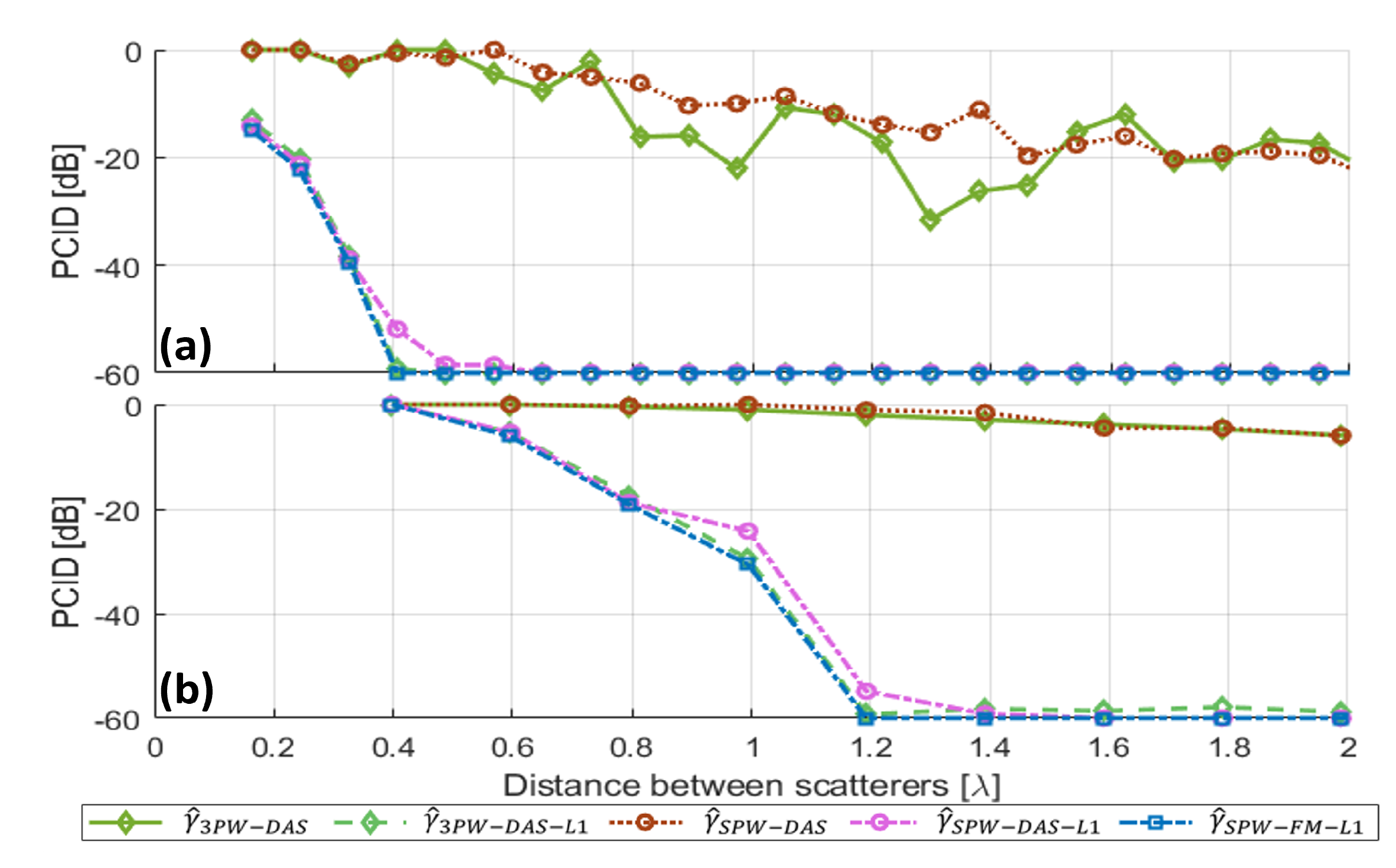
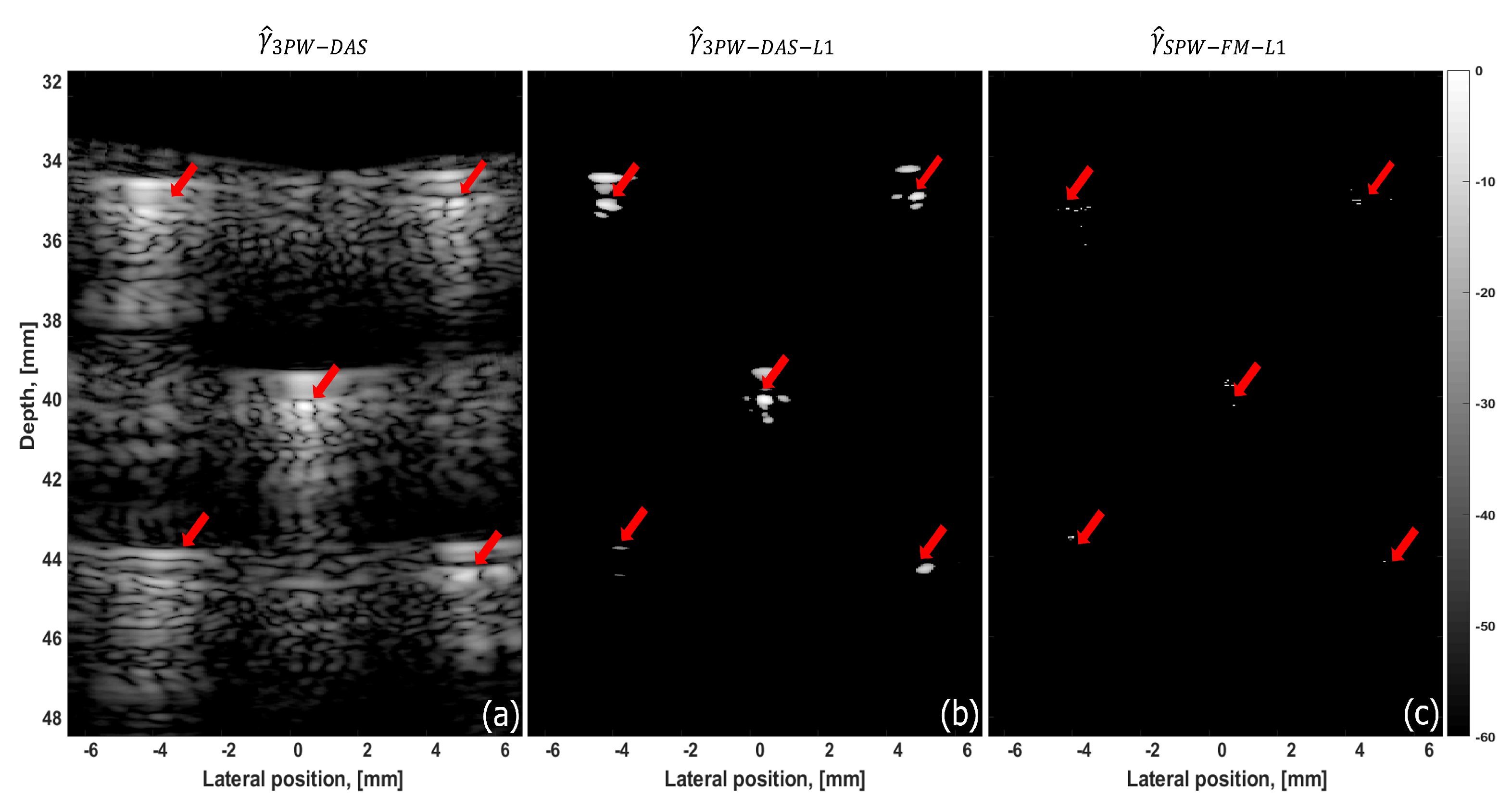
| Metric | |||||
|---|---|---|---|---|---|
| WHM | 192.5 m | 87.4 m | 244 m | 98.8 m | 25 m |
| WHM | 455 m | 177.8 m | 551.25 m | 245 m | 61.25 m |
Publisher’s Note: MDPI stays neutral with regard to jurisdictional claims in published maps and institutional affiliations. |
© 2022 by the authors. Licensee MDPI, Basel, Switzerland. This article is an open access article distributed under the terms and conditions of the Creative Commons Attribution (CC BY) license (https://creativecommons.org/licenses/by/4.0/).
Share and Cite
Nicolet, F.; Bujoreanu, D.; Carcreff, E.; Liebgott, H.; Friboulet, D.; Nicolas, B. Simultaneous Coded Plane-Wave Imaging Using an Advanced Ultrasound Forward Model. Appl. Sci. 2022, 12, 12809. https://doi.org/10.3390/app122412809
Nicolet F, Bujoreanu D, Carcreff E, Liebgott H, Friboulet D, Nicolas B. Simultaneous Coded Plane-Wave Imaging Using an Advanced Ultrasound Forward Model. Applied Sciences. 2022; 12(24):12809. https://doi.org/10.3390/app122412809
Chicago/Turabian StyleNicolet, Frank, Denis Bujoreanu, Ewen Carcreff, Hervé Liebgott, Denis Friboulet, and Barbara Nicolas. 2022. "Simultaneous Coded Plane-Wave Imaging Using an Advanced Ultrasound Forward Model" Applied Sciences 12, no. 24: 12809. https://doi.org/10.3390/app122412809
APA StyleNicolet, F., Bujoreanu, D., Carcreff, E., Liebgott, H., Friboulet, D., & Nicolas, B. (2022). Simultaneous Coded Plane-Wave Imaging Using an Advanced Ultrasound Forward Model. Applied Sciences, 12(24), 12809. https://doi.org/10.3390/app122412809







